


Our North to Seattle Amtrak Spring Break trip started in Placentia, CA, where
our friend took the three of us to the Fullerton, CA train station for our
8:05 a.m. Saturday morning departure to nearby L.A.
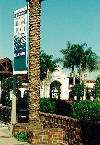 Immediately upon our
arrival at the Fullerton station, the "Desert Wind" was arriving from places
like Albuquerque, Flagstaff and originally Chicago. That was a good chance
to explain to our daughter (14) the various cars on an Amtrak Superliner
train: Coach cars, lounge cafe car, diner, sleeping cars, baggage, 3 large
boxcars for who knows what, and the engine. Quite a few people detrained.
Some stayed at the station for eventual trains south to San Diego. Our
commuter train, one of the many "San Diegans," to L.A. arrived a few minutes
late. We boarded with all our luggage (no luggage check until L.A.) and
joined a nearby full train for L.A.--some people stood for the 1-hour trip.
Arrived in L.A. on a track adjacent to the "Coast Starlight." So, we
stepped off our train and onto the "Coast Starlight" with an hour to spare
before departure. The passengers from the L.A. depot hadn't been allowed to
board yet so we had time to meet Harold, our car attendant and to walk to the
front of the train for a picture of the engines.
Immediately upon our
arrival at the Fullerton station, the "Desert Wind" was arriving from places
like Albuquerque, Flagstaff and originally Chicago. That was a good chance
to explain to our daughter (14) the various cars on an Amtrak Superliner
train: Coach cars, lounge cafe car, diner, sleeping cars, baggage, 3 large
boxcars for who knows what, and the engine. Quite a few people detrained.
Some stayed at the station for eventual trains south to San Diego. Our
commuter train, one of the many "San Diegans," to L.A. arrived a few minutes
late. We boarded with all our luggage (no luggage check until L.A.) and
joined a nearby full train for L.A.--some people stood for the 1-hour trip.
Arrived in L.A. on a track adjacent to the "Coast Starlight." So, we
stepped off our train and onto the "Coast Starlight" with an hour to spare
before departure. The passengers from the L.A. depot hadn't been allowed to
board yet so we had time to meet Harold, our car attendant and to walk to the
front of the train for a picture of the engines.
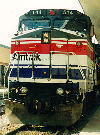 At 9:50 sharp we pulled out
of L.A. station along the L.A. river. We were one of the few to see water in
the concrete-lined river--it's dry 350 days of the year! Slowly passed
Dodger Stadium and turned west through Glendale then red rocks and green
grass between them and a long tunnel before Simi Valley where we departed 30
minutes late-we'd allowed a freight train to pass earlier and some slow time
through railroad construction workers. Harold had brought us towels, the
dining car attendant had given us our voucher for meals, the conductor had
taken our ticket--all official business taken care of, we relaxed in our
compartment .
At 9:50 sharp we pulled out
of L.A. station along the L.A. river. We were one of the few to see water in
the concrete-lined river--it's dry 350 days of the year! Slowly passed
Dodger Stadium and turned west through Glendale then red rocks and green
grass between them and a long tunnel before Simi Valley where we departed 30
minutes late-we'd allowed a freight train to pass earlier and some slow time
through railroad construction workers. Harold had brought us towels, the
dining car attendant had given us our voucher for meals, the conductor had
taken our ticket--all official business taken care of, we relaxed in our
compartment .
Our deluxe room had comfortable seating for 3--could seat 4 comfortably. Harold said the room made up into one double and one single bed. Our room was deluxe, because it had a bathroom and a shower. We were on the upper level 16 feet above the rails!
The "Dinah" opened for lunch at 11:30 and we went immediately--three cars
back. We got the last booth and later arrivals were told that they'd be
called, in about an hour, over the all-train PA. I had the chicken breast
sandwich, salad, apple pie Ala mode and unleaded coffee. Sue had the
fetticine, salad, cheesecake and berry sauce, and iced tea. Carla had pizza,
salad, ice cream and water. We finished lunch just as we pulled into Santa
Barbara station. Since the "Coast Starlight" is now non-smoking, a smoke
break was announced--we stepped off to breathe the sea air instead. We were
a few feet from the fig/banyon tree--took a couple of pictures. Next stop
San Luis Obispo is about 3 hours.
 An all-ocean view from our window--since
Ventura. Not a cloud in the sky, about 70 degrees, channel islands about 20
miles off the coast clearly visible. The land side of the train fresh and
green from the recent rains.
An all-ocean view from our window--since
Ventura. Not a cloud in the sky, about 70 degrees, channel islands about 20
miles off the coast clearly visible. The land side of the train fresh and
green from the recent rains.
Vandenburgh Air Force base becomes visible on the right with it's large vehicle assembly bldg. with the American flag painted on the side, then the Titan II SLCs (Space Launch Complexes). For 30 minutes we ride through Vandenburgh! A few people on the beach near the northern border. Saw 2 deer watching the train pass. Lots of yellow flowers and iceplant. Many miles of beach without anyone but our train to enjoy it!
Northern border of Vandenburgh is a large valley which we turn inland and follow to enter some rolling hills and eventually San Luis Obispo. Pismo Beach comes prior to San Luis Obispo--just a single glimpse of the ocean--lots of sand dunes though. At San Luis, Carla and I had walked through the train to take a picture out the back of the tracks but were blocked by an unoccupied, locked diner. Met up with an Amtrak person who said they were taking it to Oakland to be unhooked and sent east with another train. During the smoking stop at San Luis, Carla and I detrained and walked the platform back to our car, to say hi to Sue from outside her car, then back to the lounge cafe to wait for the horseshoe curve.
 North of San Luis Obispo is the men's prison, but more importantly, the
horseshoe curve where we took a picture of the front of the train, coming
around the 180 degree curve.
North of San Luis Obispo is the men's prison, but more importantly, the
horseshoe curve where we took a picture of the front of the train, coming
around the 180 degree curve.
While watching the velvety green hills pass with cattle "lowing", we saw 4 deer watching us pass by.
Dinner was announced. The lady in charge of the diner said she'd be by to give us a choice for dinner time (reservations only). 5, 5:30, 6:30, 7:15 or 8. We'll try for 5:30. Judy gave us our desired reservation.
Facts: LA to Seattle is 1390 miles.
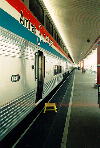 Sleeper cars have deluxe bedrooms upstairs as well as 10 2-people 2-beds
rooms. Lower level has 4 of the same 2-people rooms and one large room the
width of the train and a similar train-width room marked handicapped (it has
a restroom) You enter the train on that level so that's why it's labeled
handicapped because the deluxe rooms have bathrooms and showers too.
Downstairs the rooms share a dressing room/toilet and 3 toilets. Upstairs
there is one toilet (in addition to the rooms). All through-train travel
takes place on the upper level. The only thing between us and the engines is
a 1/2 coach 1/2 employee dorm car. The coach part has college kids returning
to Pacific Lutheran College after their vacation, I guess. There's hardly
any traffic past our room. One trip through coach, however, reemphasizes the
importance of getting a room when you travel long distances on the train.
Sleeper cars have deluxe bedrooms upstairs as well as 10 2-people 2-beds
rooms. Lower level has 4 of the same 2-people rooms and one large room the
width of the train and a similar train-width room marked handicapped (it has
a restroom) You enter the train on that level so that's why it's labeled
handicapped because the deluxe rooms have bathrooms and showers too.
Downstairs the rooms share a dressing room/toilet and 3 toilets. Upstairs
there is one toilet (in addition to the rooms). All through-train travel
takes place on the upper level. The only thing between us and the engines is
a 1/2 coach 1/2 employee dorm car. The coach part has college kids returning
to Pacific Lutheran College after their vacation, I guess. There's hardly
any traffic past our room. One trip through coach, however, reemphasizes the
importance of getting a room when you travel long distances on the train.
Dinner in the diner was delicious. Carla pointed out that the reason it was so good, compared to airplane food, it is prepared "onboard". We all enjoyed dinner: Carla had New York steak--very tender, with baked potato, salad and she chose ice cream again for desert. Sue had prime rib (Chef's special), also very tender, with mashed potatoes, vegetables, and chocolate cake. I had baked halibut, baked potato, salad, and apple pie ala mode again.
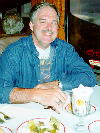 During dinner we "floored it" (as Carla says) though the Salinas Valley-too
early this year to see the artichokes. Sun set during dinner and only an
orange western glow as we returned to our room. Judy told us breakfast was
from 6 to 9:15.
During dinner we "floored it" (as Carla says) though the Salinas Valley-too
early this year to see the artichokes. Sun set during dinner and only an
orange western glow as we returned to our room. Judy told us breakfast was
from 6 to 9:15.
The train goes directly through Jack London square--right down the middle of the street, at about 10 mph. After the Oakland stop, we rang for Harold to make up our beds. As advertised, there was a bunk single bed and the day couch made into a "double"--it was a stretch to call this a double but Carla and Sue managed--with a chair next to Sue's head providing a place for her arms.
About 7:30 a.m. on Sunday I thought I heard rain on top of the car. After pulling the curtain and checking, I found that there wasn't a cloud in the sky-- beautiful, clear, mountain air south of Klamath Falls, OR. We slowly got ourselves up--it was hard not looking out the windows at the large Klamath Marsh with grass which held hundreds of Canadian geese and other water fowl--for miles.
At the Klamath Falls stop I took the opportunity of no rocking and rolling to take a shower. Boy that must have been a sight--a bathroom the size of an airplane bathroom with a hand-held shower head and a drain in the floor! I got the job done before we continued our travel north.
Norther California and OR have very nice tracks compared to their southern counterpart--both are Southern Pacific but the ride is noticeably smoother up here.
PA announcements about tables in the diner being available for people who had put in their names for tables prompted us to continue getting ready. I went to the diner to see about putting in our name and Judy said there was room right then. I asked her to call "Morrison party of 3" on the PA so I wouldn't have to go back 3 cars to get them. She did and Sue and Carla soon arrived for breakfast of 2-eggs, bacon, toast and or, tomato juice, or coffee.
Back in our room we continued our climb, through increasing snow on the ground, to Cascade Summit, then a drop down 3,600 feet in 44 miles-beautiful pine trees with snow on the ground 4 ft. deep according to a snow marker we saw.
Coming down to Eugene from Cascade Summit was a two-hour arrival of spring. The farther down the mountain we came, the more springlike it got. Snow went from 4 feet to 6 inches to none at all. Grass became green and redbud trees and daffodils appeared in the yards of homes along the way. Lookout lake had no ice or snow around it and bass fishermen (both of them) were enjoying the sun. A fly fisherman enjoyed a mile of river all to himself. Cattle enjoyed the fresh green grass. Families, on this Sunday morning, were setting up for outdoor activities-babies dressed to the hilt form earlier church services.
 At Eugene, we got back on, after a walk on the platform, and entered the
diner. They had advertised that they had some dinner entrees so we enjoyed
salmon (delicious) and Carla had another steak.
At Eugene, we got back on, after a walk on the platform, and entered the
diner. They had advertised that they had some dinner entrees so we enjoyed
salmon (delicious) and Carla had another steak.
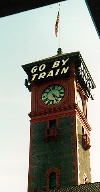 Portland, after long waits before proceeding across the draw bridge to the
station, still sunny and warm. We mailed post cards and picked up some Dr.
Pepper for the final leg. Soon after Portland, were some of our passengers
detrained and boarded the "Empire Builder" heading east. We left Portland
and soon crossed the Columbia River, with Mts. Hood and St. Helens in clear
view, into Washington state (5:00 p.m.).
Portland, after long waits before proceeding across the draw bridge to the
station, still sunny and warm. We mailed post cards and picked up some Dr.
Pepper for the final leg. Soon after Portland, were some of our passengers
detrained and boarded the "Empire Builder" heading east. We left Portland
and soon crossed the Columbia River, with Mts. Hood and St. Helens in clear
view, into Washington state (5:00 p.m.).
The Conductor had mentioned, entering Portland, that this kind of weather wasn't expected until July usually.
Watched the sun slowly sink in the west. "Last call for dinner in the diner" was at Kelso-Longview, WA (so they could be closed by Centralia). We had "dinner" at lunch time and were not hungry at all BUT since meals are included, we went on down. Knowing that it takes about 1 1/2 hours to eat on the train, we decided we might be hungry by the time it was served. We all ordered cheeseburgers, and, sure enough, by the time it arrived, we were hungry enough to eat them--no desserts though.
I calculated that the Fullerton-Seattle round trip for three cost us $295 ($100 each) and the room for 2 nights and meals for 4 days cost us $660--that's about $55 a night and $5.50 each per meal. The greatest advantage is not having to drive and having your own compartment all the way--not riding in the cattle cars.
At lunch, a partner in a CPA firm, at 101 California in San Francisco, who was in charge of computer systems, joined us. He had 7 kids and was a graduate of BYU. He was returning from work in the Seattle Area to the Bay Area. He was working on a Mac portable 180 in his room, he said. We discussed IBM vs. Mac. He IBM stood for "I Became Macintosh." He worked on a Marketing Plan for his company's software following a book, "Writing a Marketing Plan in One Day." He said the first sentence said you should put in three days planning before writing your one-day plan. I saw him at long train stops, and he said he was making good progress on his plan.
After lunch, it got partly cloudy (it had been cloudy in Seattle) as we motored south "scanning all the way." We input city police and fire frequencies as we passed towns on the route--Tacoma, Portland, etc. At Portland, we got off and bought soft drinks and candy bars in the Station. We were delayed 50 minutes while they "fixed a signal on the bridge." We made our 6:30 dinner reservations with dining car attendant, Cecil.
We passed Salem, OR, state capital, 45 minutes late.
At the 6:30 dinner, Carla, our daughter, and I had steak and baked potato, wife, Sue, had salmon. For dessert, I had pie ala mode, Carla had ice cream, and Sue had cheesecake.
After dinner, more scanning--the most common message was "SP mile marker 554.2, 68 mph, no defects, no defects," in a woman's voice. I read some more of my "Railfan" and "Railroad" magazines which I had purchased in the Seattle station.
Went for milk about 9:30 in the lounge car to have with my cookies from Larry's Market in Kirkland, WA. Lounge attendant, John Kelly, and I discussed the Grand Canyon, because I had a Grand Canyon tee-shirt on. The conversation extended to Grand Junction, which he said was a great place to vacation, as well as Monument Valley. John confided that Amtrak was a great company to work for--many entry-level jobs which most high school students would be looking for. He said Amtrak recognizes good work ethic and initiative and promotes quickly. He said he'd been working for them for less than a year and they were already talking about training him for the "Chief of Onboard Services" job. He said it paid about $40,000, and after 20 years you are vested in retirement--a great job for an 18 year old who could have retirement vested by age 38. He said he was 45 and was just hired. He said they had just hired a 59 year old. I asked what training he'd have to have for the C.O.S. job, and he said a couple of training runs--sounds like most of their training is on-the-job. On the way up to Seattle, I had noticed a 'trainee' for the lounge attendant's job. John said he'd been a sleeping car attendant and really liked that job because you were able to talk with people. I asked when they slept, since they seemed to be up past when I went to bed and before I arose, and he said about 4 hours a night. He said you have to be up early to get coffee and juice ready for the car and meals for those in the handicapped room.
I told John that I was in charge of a Career Day for the high school where I taught, and he told me to contact the Head of Personnel, in Los Angeles at 213 683-68647.
The next day we heard our car attendant, Bronson, announce, "6:30" to the passenger in the room next to us, so I didn't get much sleep after that. I got up at 7:30 and took a shower and went for coffee--none in our car, so I walked to the next sleeper car where the female attendant has some ready. Bronson had left us a paper so I took the paper and coffee to the lounge while Sue and Carla finished their night's sleep and got dressed. While in the lounge car, around Martinez, CA, I saw the U.S. mothball fleet off to the east, or at least part of it--maybe 8 ships. After paper and coffee, I went back to the room and they announced that the dining car would be closed until after Oakland. John Kelly announced that his lounge car would be closed also, while he put out his "Amtrash" at Oakland.
In Oakland, I stepped off with Carla and noticed the crew change--the 2 engineers spoke briefly. A railroad worker walked the train touching each axle. I said, "No more hot boxes, huh?" He said hobos used to start fires in their camps by taking hot waste from the boxes, but roller bearings were used now and they seldom got hot. He spoke intelligently, but looked a mess. As soon as the "Amtrash" had been dropped, and the 1800 gallon fuel tanks were refilled on engine 514, we 'highballed' out of Oakland. We three went for breakfast as we viewed Oakland south of the station--it had been dark when we came north, so we wanted to see the scenery. It was probably the most graffiti we'd seen anywhere, also the most artistic--multicolored, outlined names. Back in our rooms after breakfast, we headed for Salinas, CA. Since breakfast was late, we went for the 'last call' for lunch and viewed the mountain range north of San Louis as we ate. Beautiful green rolling hills as we descended to San Louis. I had written my parents a 'driftwood postcard' which I had picked up on south Beach, San Juan Island, and mailed it in the station in San Louis.
Carla enjoyed the new scanner, 161.550 frequency of the Amtrak "road" channel and the most active frequency. In addition to the automated message about mile marker, speed, and no defects, we also heard trainmen communicating with each other and with the station dispatchers. Permission to leave each station is "11 highball" for our Train 11. Then the engineer would whistle two times and we'd be off. We'd check our 'listener's guide' book, program in local frequencies, and listen for police and fire information in the towns we passed. We had bought the cheapest Radio Shack scanner ($80) but it was fine for what we wanted to do. It had 10 programmable channels. The most expensive scanner was about $300 and had 200 programmable channels. We just left it to scan all the channels we'd entered and it would stop and listen to whatever was being said on any channel. Then, after 3 seconds of silence on that channel, it would begin scanning again.
At the San Louis Obispo Station, Roscoe Brown, actor, boarded the train and settled into a room next to ours, whose tenants had detrained earlier in the day. Bronson had cleaned the room after they left. We had just gotten lunch, and the lunchroom was closed, but Roscoe asked our attendant, Bronson, for lunch in his room. He said something about 4:30, so he may have only planned to go to Santa Barbara.
After leaving San Louis Obispo, we heard on the scanner that a lady had left her purse on board when she got off there. The northbound Coast Starlight, Train 14, soon passed us, as we waited on a siding, and an attendant handed it off to them to take back to San Louis.
As we continued along the coast, around Vandenburg Air Force Base, where no roads go, we watched the few people on the mostly uninhabited beach for miles. What makes people turn from what they are doing, when they hear a train passing by, and watch and wave? When I was a kid working on our farm, I can understand turning from WORK to take a break and wave at the engineer in the engine, and workmen in the caboose. Still nowadays, people from kids to old timers, turn from whatever they're doing and watch and wave. Whether it be fishing, hiking, riding a bicycle, jumping on a trampoline (where kids didn't stop jumping to wave), playing golf, riding on a passenger train waiting on a siding, or working in the yard or a garden.
The Coast Starlight route through both Oregon and Washington is different from California in one important factor--water. In Oregon and Washington, rivers are always full and running, farm ponds are full, mud puddles are everywhere, fields are draining water. California has dry streams, rivers and lakes.
As we returned to L.A. through Santa Barbara, Ventura, Oxnard then cutting inland and arriving, my thoughts returned to the great trip we'd had in the great Northwest. My thoughts ran back over the visits to Edmonds and LaConner, Washington; the ferry rides through the islands of Lopez, Shaw, Orcas and our visit on San Juan Island; the daffodil fields; visiting out niece and nephew's home overlooking San Juan de Fuca Strait; the moonlight walks there; the fireplace flickering in the picture windows; the lighthouse and it's rhythmic signal; the lunch and shopping in Friday Harbor; the vista from the cliffs at Cattle Point, watching gulls and bald eagles near the house; the boat ride to a favorite spot to drop the crab basket; the driftwood covered South Beach; the farm barn pictures I took; the many coffee shops; wow, what a beautiful part of the USA. Taking the Coast Starlight from L.A. to this wonderful vacation near Seattle, and returning home from Seattle, made it a perfect spring break vacation--try it sometime!
Carl found us while visiting the home page of the new book, "24 Hours in Cyberspace," on the Internet. Carl and Sue live in Placentia, Orange County, California. Carl teaches at Cypress High School, Cypress College, and California State University Fullerton.
I have also posted a humorous story, "Fire in the Hold! - The Day my computer Lab almost melted down!" at the National Education Association's site. If you have time, please check it out and let me know what you think.